
Hospital Services- Anesthesia
Anaesthesia refers to a state of no sensation and can be general, regional or local. General anaesthesia involves drugs which induce a deep sleep; regional anaesthesia (epidural/spinal) involves injecting drugs around the spine to numb the legs and abdomen; local anaesthesia involves injecting drugs into the skin to numb a small area. Sedation involves drugs that produce sleepiness or a light sleep but stop short of general anaesthesia.
All of these techniques can be used alone or in combination depending on the specific procedure. The decision as to which is best for your situation will be made by your consultant anaesthetist after a discussion with you.
Anaesthesia may be used to:
• Relax you.
• Block pain.
• Make you sleepy or forgetful.
• Make you unconscious for your surgery.
An Anaesthesiologist is a medical doctor specially trained in perioperative care. They review a patient’s medical record and will meet with them to discuss their medical conditions in order to determine the impact anesthesia may have on their care. The anaesthesiologist will check with the patient for a list of medications he/she takes and any reactions that they may have had in the past to anaesthesia. The Anaesthesiologist will perform a brief physical examination to make sure that there is no problem which may make the surgery/anaesthesia unsafe.
Once the Anaesthesiologist has determined that the patient’s medical condition is satisfactory, he/she will discuss the type of anaesthesia chosen that best suits the case. The Anaesthesiologist may offer alternative anaesthetic techniques if appropriate. The advantages and disadvantages of each type of anaesthesia will be explained and they will make sure the patient understands what is going to happen. If necessary, they will also discuss the reasons for the use of any special monitors that may be needed to ensure the patient’s safety during surgery. The IV (intravenous catheter) could be placed by the Anaesthesiologist and will be used to administer medications and fluids in the operating room.
Preoperative Sedation
Because most people are nervous about their impending surgery and anaesthesia, the Anaesthesiologist may give some medication to relax a patient before going into the operating room. This medication may or may not make the patient sleepy. If any special monitors are going to be placed, the Anaesthesiologist may decide to give additional sedation to make the placement of these monitors easier. Again, the type and amount of sedation given will be tailored to the patient’s needs and medical condition. In our same day surgery centres, patients are unlikely to receive medication for relaxation as these medicines may linger and cause excessive sedation after surgery.
Although this plan will be the basic framework of a patient’s anaesthesia, there may be unexpected events during the surgery that may require the anaesthetist to deviate from this plan.
Post-operative pain management- The management of pain after the surgery is important to us. Once again, based on the procedure, medical history, and other considerations, we may be able to offer some methods to better treat the patient’s postoperative pain.
Monitors
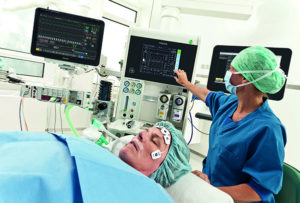
After arriving in the operating room, several monitors will be applied routinely during your procedure.
They include:
Anaesthesia WorkStation
Depth monitor
Ultrasound Machine
Blood pressure cuff – This will tell us the blood pressure throughout the case.
Pulse oximeter – This monitors the pulse and the amount of oxygen saturated in the patient’s blood.
EKG monitor – Monitors the electrical activity of the patient’s heart.
Other monitors used to observe the status include:
Heart and lung sounds with a special stethoscope
Patient’s body temperature
The amount of oxygen and carbon dioxide they are breathing in and out and the amounts of medicines administered to the patient with the anaesthesia machine.
Types of Anaesthesia
Local Anaesthesia:
This type of anaesthesia numbs a small part of the body for minor procedures. For example, the patient may get a shot of medicine directly into the surgical area to block pain. They may stay awake during the procedure.
Monitored Anaesthesia Care (MAC):
MAC stands for Monitored Anaesthesia Care. Monitors to evaluate the heart (EKG), oxygenation (Pulse oximeter), and blood pressure are used. With this category of anaesthesia, patients can expect to receive sedation, which is usually with a variety of medications administered through an intravenous catheter. These medications are very effective for treating anxiety and pain. A sleepy state, also sometimes called twilight anaesthesia, is achieved before the start of the procedure. Breathing tubes are not required as patients continue to breathe without assistance. Supplemental oxygen is usually administered through a plastic face mask or nasal prongs. The medicines administered usually cause a state of amnesia so patients are unlikely to remember much of what happens in the operating room. Since this is not general anaesthesia, the patient may find that they can hear voices and experience some sensation. Surgeons often inject local anaesthetics to numb the area they are operating on so that the patient will not experience any pain. The level of sedation can be adjusted to the patient’s level of comfort.
Benefits
– By using MAC anaesthesia, the patient can avoid the side effects of general anaesthesia. Patients are usually able to leave the recovery room and return home much sooner.
General Anaesthesia:
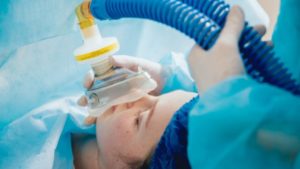
This type of anaesthesia involves a complete loss of consciousness. Monitors for the heart (EKG), oxygenation (Pulse oximeter), blood pressure, and temperature are used. Supplemental oxygen is given through a facemask. Medications are then given through an intravenous catheter to induce unconsciousness in the patient. After ensuring unconsciousness, a breathing tube is usually inserted in the mouth.
There are two types of breathing tubes that can be used. For procedures that do not involve the muscle of respiration, and where muscle relaxation is not required, a laryngeal mask airway (LWA) is commonly used. This type of breathing tube rests in the throat and does not extend into the trachea (your windpipe). Usually, the patient breathes on his/her own, and a ventilator is not used. The second type of breathing tube is an endotracheal tube (ETT). This plastic tube is inserted into the throat past the vocal cords and into the trachea. A cuff is inflated to form a seal so that oxygen and anesthetic gases can be delivered with a ventilator.
During the procedure, muscle relaxants may be used so the surgeon can gain better access to the operative site. Anaesthetic gases, as well as intravenous medications, may be administered throughout the procedure to keep the patient asleep and without pain.
Upon awakening from general anaesthesia, the anaesthetic gases are turned off and the breathing tube is removed as soon as the patient is breathing on his/her own, and able to respond appropriately. On rare occasions, or for very extensive procedures, the breathing tube may be left in place until certain criteria are met so that the breathing tube can be removed safely. This may occur in the post anaesthesia care unit (PACU), or one of the critical care units.
Benefits
– General anaesthesia is sometimes the only option available for major operations. This option often provides the best operating conditions for the surgeon. The patient will be completely unconscious and unaware of anything happening in the operating room.
Regional anaesthesia
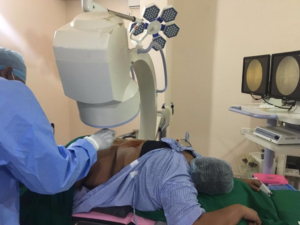
This type of anaesthesia blocks pain to a larger part of your body. You may also get medicine to help you relax or sleep. Types of regional anaesthesia include:
1. Spinal and Epidural anesthesia-
This is a shot of anaesthetic near the spinal cord and the nerves that connect to it. It blocks pain from an entire region of the body, such as the belly, hips, or legs.
Spinal Anaesthesia:
After numbing the skin in the lower back, a very thin needle is inserted to deposit a small amount of local anaesthetic in the spinal canal to numb the nerves. The numbness usually lasts about two to four hours. The time period can vary from person to person and will also depend on how much and what kind of local anaesthetic is given. The patient will feel warmth or a pins and needles sensation in the legs as the nerves are blocked. Within a few minutes, there will be a loss of sensation to cold or sharp objects. Feelings of light touch and pressure may remain throughout the procedure, which is normal. The patient will be tested for loss of sensation to pain prior to starting the procedure.
Types of Procedures:
Typically used for gynaecologic (e.g. hysterectomies) and urologic (e.g. prostate) surgeries, as well as surgeries of the lower extremities (e.g. knee surgery).
Benefits
-Spinal anaesthesia works well in providing good pain control for surgery. Before the patient experiences severe pain, pain medications can be given as the block wears off. Very little local anaesthetic is given, so the patient can be wide awake or sedated. Pregnant patients will benefit, as there is minimal medication to interact with the foetus.
Epidural Anaesthesia:
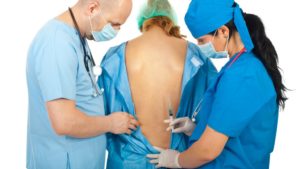
This is very similar to spinal anaesthesia. The major difference is that a catheter is introduced through a needle in the low or mid back. The catheter can remain for several days, providing continuous delivery of local anaesthetics, which continue to numb the nerves and provide pain relief to the surgical area. The catheter does not penetrate the membrane covering the spinal canal, so the patient is not at risk for developing a spinal headache unless the membrane is accidentally punctured. Because a catheter is left in place, epidural anaesthesia, as opposed to spinal anaesthesia, is well suited for long procedures of the lower extremities or where postoperative pain control is desired. Epidural anaesthesia is commonly used for thoracic surgery, radical prostatectomy, and for obstetric patients in active labour.
Types of Procedures:
Typically used for labour, caesareans (C-sections) and surgeries of the colon and gastrointestinal tract.
Benefits –
By using epidural anaesthesia, the side effects of general anaesthesia can be avoided. Epidural anaesthesia is usually a very effective means of postoperative pain control.
2. Peripheral nerve blocks-
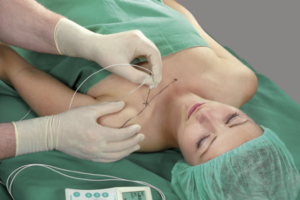
This is a shot of anaesthetic to block pain around a specific nerve or group of nerves that provide sensation to the site where the surgery is planned. Blocks are often used for procedures on the hands, arms, feet, legs, or face. Typical areas that are blocked include:
Cervical plexus – Nerves in the neck can be numbed for carotid endarterectomies to be performed under MAC anaesthesia.
Interscalene block – Nerves in the neck can be blocked to numb the shoulder and upper arm. A device called a nerve stimulator, which delivers electrical impulses to the nerves, is used to help ascertain when the needle is close to the nerve.
Alternative nerve block –
There are many nerves in the vicinity that can all be blocked. The phrenic nerve innervates the diaphragm, which is the major muscle used for breathing. There are two phrenic nerves, so if one is blocked the other usually is sufficient, although the patient may feel as if he/she has to work a little harder to breathe. The eyelid may also droop and the pupil may be less reactive as nerves to the eye can also be blocked. Hoarseness may result if the recurrent laryngeal nerve is blocked since this nerve innervates the vocal cords. These side effects will diminish as the block wears off.
Axillary –
Nerves in the armpit are blocked for surgery in the lower arm
Femoral/Sciatic –
Nerves in the groin and buttocks are blocked to allow surgery in the knee and leg
Popliteal –
Nerves behind the knee are blocked to allow surgery in the lower leg
Ankle –
Nerves in the ankle are blocked to allow surgery in the foot
Benefits –
Epidural anaesthesia provides good postoperative pain control. The block can last for many hours, so as sensation returns, the patient can take pain medications to control the pain before it becomes severe. Also, general anaesthesia is usually not required, so its side effects can be avoided
Top comments
- No Comments Yet For This Post
-
Post Your Comment Here